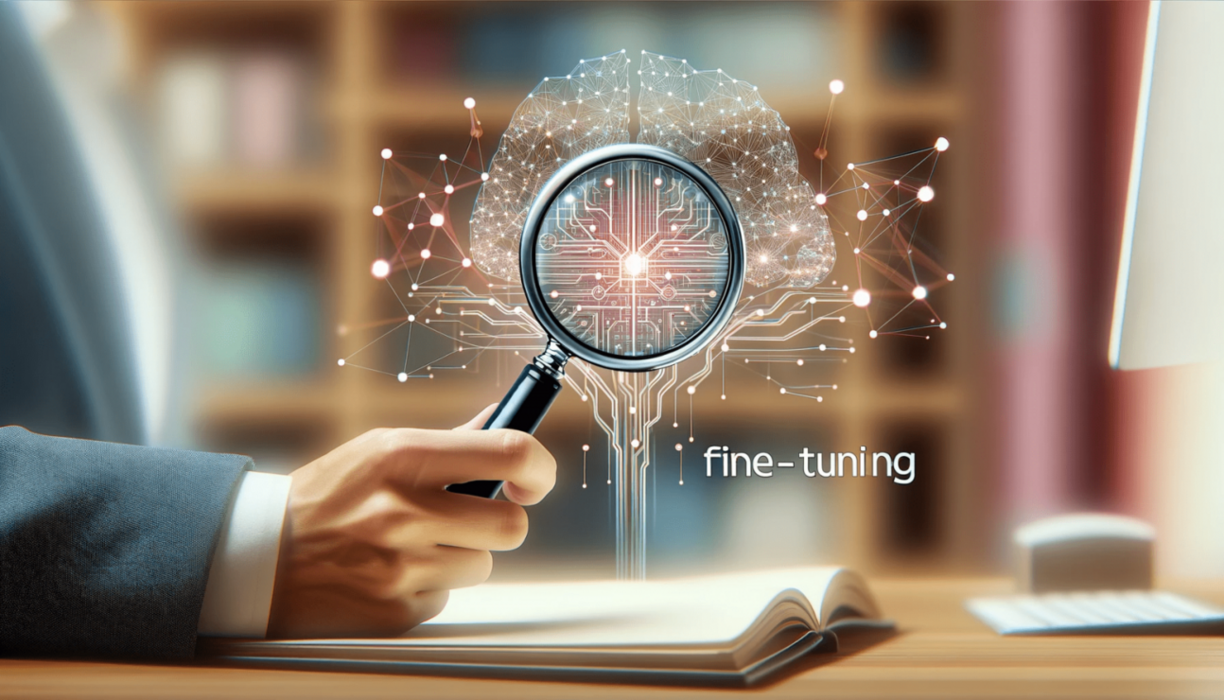Fine-Tuning: An Innovative Technique for Language Models
In the realm of natural language processing, LLMs (large language models) have experienced significant growth in recent years. As cornerstones of generative AI, these models have paved the way for numerous applications such as language translation, data evaluation, and intelligent chatbots.
However, these models heavily rely on optimization techniques and prior training. At the heart of these advancements lies a key technique: fine-tuning. This process allows pre-trained models to specialize in specific tasks, enhancing versatility and performance.
This article delves into fine-tuning, its applications, benefits, and challenges, supported by recent technical documents.
What is Fine-Tuning?
Fine-tuning is an optimization method for pre-trained machine learning models. Unlike initial training that requires massive datasets, fine-tuning focuses on more limited and specialized data. The goal is to improve the model’s performance on a particular task while preserving previously acquired knowledge.
Pre-trained models, such as GPT and BERT, are trained on vast datasets to capture general knowledge applicable to various tasks. However, for specific applications, these models need to be adjusted through fine-tuning. For example, a natural language processing (NLP) model can be fine-tuned for legal document classification or detecting emotional tone in texts.
How Does It Work?
1. Preparation of the pre-trained model :
- Select a model already trained on a large dataset. For image recognition, models like ResNet, VGG, or Inception trained on the ImageNet database are used. For NLP, models like BERT, GPT, or RoBERTa, trained on extensive text collections, are utilized.
- Use deep learning tools such as TensorFlow or PyTorch to load this pre-trained model. This means importing the model’s structure and weights (parameters learned during training).
- Ensure the pre-trained model is compatible with the specific task you want to adapt it for.
2. Preparation of specific data :
- Gather a representative dataset for the specific task. For example, images of new categories of objects or texts in a specific domain like medicine, law, or education.
- Preprocess the data: for images, this might include resizing, normalization, and data augmentation; for texts, it might involve tokenization, text cleaning, or creating training datasets.
3. Model adaptation :
- Adjust the final layers of the model to match the new task. Add specific layers if the new task requires a slightly different architecture.
- Set training hyperparameters: determine parameters like learning rate (the speed at which the model learns), number of epochs (how many times the data is passed over), and batch size (the number of examples used at each learning step).
- Apply transfer learning, where the initial layers (capturing general features) remain fixed or are slightly adjusted, while the final layers are retrained more significantly.
- Use progressive training: initially, only the new layers are trained, then the earlier layers are gradually adjusted with a low learning rate.
4. Training :
- Start the training process using the new dataset. The model adjusts its weights to minimize the loss function defined for the new task (a measure of the model’s error).
- Monitor the model’s performance on a validation set to avoid overfitting (when the model becomes too good on the training data but performs poorly on new data). Techniques such as early stopping are used to halt training if validation performance stops improving.
5. Evaluation and refinement:
- Evaluate the fine-tuned model’s performance on an independent test set to verify its generalization ability.
- Use task-specific metrics, such as precision, recall, F1-score, or accuracy, to measure the model’s performance.
- If performance is unsatisfactory, readjust the hyperparameters using regularization techniques like dropout or normalization, or collect more data for retraining.
- Repeat the training and evaluation process until the desired performance is achieved. This may include fine-tuning hyperparameters, modifying data preprocessing, or optimizing the model architecture.

Applications of Fine-Tuning
Fine-tuning is useful in many applications, from computer vision to medicine. In computer vision, a pre-trained model on generic images can be fine-tuned to detect specific objects, such as in autonomous vehicles or medical images. In NLP, it can be used for tasks such as document classification or automatic translation.
Examples of applications :
1. Médecine : Pre-trained models can be adapted to analyze medical images and detect specific anomalies, such as tumors in X-rays or MRIs.
2. Customer service : In customer service, an NLP model can be fine-tuned to understand and respond to common customer queries, improving efficiency and user satisfaction.
3. Finance : Models can be adjusted to analyze financial documents, detect fraud, or predict economic trends.
4. Education : Adaptive learning systems can be fine-tuned to personalize student learning paths, catering to their specific needs and learning pace.
5. Marketing : Recommendation models can be fine-tuned to personalize offers and advertisements based on user behavior and preferences, increasing engagement and conversion rates.
6. Cybersecurity : Intrusion detection models can be fine-tuned to identify suspicious behavior and specific attacks by analyzing security logs and real-time data streams.
7. Law: NLP models can be adjusted to analyze contracts, extract relevant legal information, and assist lawyers in legal research and document drafting.
8. Human resources: Models can analyze resumes and cover letters, identify top candidates for a position, and predict cultural fit with the company.
Tools and libraries
The success of fine-tuning also depends on the available tools and libraries. TensorFlow and PyTorch are among the most popular frameworks due to their advanced features. Platforms like Hugging Face also offer pre-trained models and tools to facilitate the process. Visualization tools like TensorBoard enable real-time monitoring of model performance during fine-tuning.
Main tools used :
1. TensorFlow : Developed by Google, TensorFlow offers a wide range of fine-tuning tools, including APIs for transfer learning and modules like TensorFlow Hub.
2. Keras : A high-level interface for TensorFlow, Keras simplifies fine-tuning for less experienced users with its modular approach.
3. PyTorch : Known for its flexibility and ease of model layer manipulation, PyTorch is a preferred choice among AI researchers.
4. Hugging Face : This platform offers a library called Transformers, containing pre-trained models for various NLP tasks.
5. TensorBoard : A visualization tool for TensorFlow that tracks model performance in real-time during fine-tuning.

Benefits of Fine-Tuning
Fine-tuning large language models offers companies an opportunity to reap the benefits of artificial intelligence by precisely adapting these models to their specific needs. In addition to reducing costs and development time, fine-tuning allows companies to stay competitive and innovative by quickly adapting their AI solutions to market changes.
From improving customer service to managing internal operations, the advantages of fine-tuning manifest in a multitude of applications:
1. Cost reduction and time savings: Fine-tuning reduces the costs and time required to train language models. Instead of training a model from scratch, which requires massive computing resources and datasets, companies can use pre-trained models and quickly adjust them to their specific needs. This allows for faster deployment of AI-based solutions and optimization of available resources.
2. Improved accuracy and performance: Fine-tuned models can deliver superior performance on specific tasks compared to generic models. By adjusting pre-trained models with specialized data, companies can improve the accuracy of predictions and analyses.
3. Flexibility and versatility: Fine-tuning offers great flexibility and versatility, allowing companies to quickly adapt to market changes and new needs. Models can be adjusted for new tasks or to incorporate recent data, ensuring AI solutions remain up-to-date and relevant. This adaptability is especially important in dynamic and competitive environments where requirements can change rapidly.
4. Innovation acceleration: Fine-tuning facilitates innovation by allowing companies to quickly test new ideas and explore new AI applications. Models can be adjusted for prototypes and pilot projects, reducing the time needed to move from idea to implementation. This ability to experiment quickly encourages innovation and helps companies stay competitive.
5. Security and compliance: By adjusting language models to specific industry needs, companies can better meet security and compliance requirements. For example, in the banking sector, fine-tuned models can be used to detect fraud with greater accuracy while adhering to regulations and data privacy standards. This enhances operational security and ensures compliance with laws.
Conclusion
Fine-tuning is an essential technique for fully exploiting the potential of machine learning models in specific applications. Despite presenting challenges, its advantages in terms of performance and specialization make it an indispensable tool for companies seeking to integrate advanced AI solutions.
By using fine-tuning, companies can significantly improve their operational efficiency, optimize their processes, and offer products and services better suited to their customers’ needs. As technology evolves, methods like instruction tuning promise to make models even more versatile and performant, providing companies with a major competitive advantage in an increasingly competitive market.




